This is a list of aviation-related events from 1984.
This is a list of aviation-related events from 1984.
The deadliest crash of this year was Aeroflot Flight 3352, a Tupolev Tu-154 which crashed on landing in Omsk, Russian SFSR on 11 October, killing 174 of the 179 people on board, as well as four on the ground.

The Iran–Iraq War, also known as the First Gulf War, was an armed conflict between Iran and Iraq that lasted from September 1980 to August 1988. Active hostilities began with the Iraqi invasion of Iran and lasted for eight years, until the acceptance of United Nations Security Council Resolution 598 by both sides. Iraq's primary rationale for the attack against Iran cited the need to prevent Ruhollah Khomeini—who had spearheaded the Iranian Revolution in 1979—from exporting the new Iranian ideology to Iraq. There were also fears among the Iraqi leadership of Saddam Hussein that Iran, a theocratic state with a population predominantly composed of Shia Muslims, would exploit sectarian tensions in Iraq by rallying Iraq's Shia majority against the Baʽathist government, which was officially secular and dominated by Sunni Muslims. Iraq also wished to replace Iran as the power player in the Persian Gulf, which was not seen as an achievable objective prior to the Islamic Revolution because of Pahlavi Iran's economic and military superiority as well as its close relationships with the United States and Israel.

The Strait of Hormuz is a strait between the Persian Gulf and the Gulf of Oman. It provides the only sea passage from the Persian Gulf to the open ocean and is one of the world's most strategically important choke points. On the north coast lies Iran, and on the south coast lies the Musandam peninsula, shared by the United Arab Emirates and the Musandam Governorate, an exclave of Oman. The strait is about 90 nautical miles (167 km) long, with a width varying from about 52 nmi (96 km) to 21 nmi (39 km).
This is a list of aviation-related events from 1982.
This is a list of aviation-related events from 1983.
This is a list of aviation-related events from 1985.
This is a list of aviation-related events from 1986.
This is a list of aviation-related events from 1987.
This is a list of aviation-related events from 1988.
This is a list of aviation-related events from 1991.
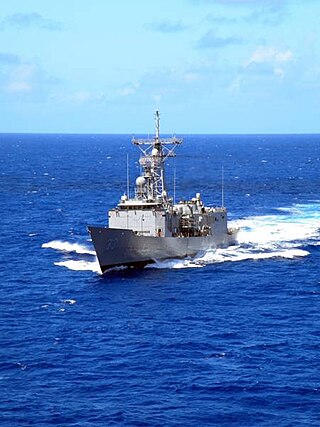
USS Jarrett (FFG-33), was the twenty-fifth ship of the Oliver Hazard Perry-class guided missile frigates, was named for Vice Admiral Harry B. Jarrett (1898–1974).
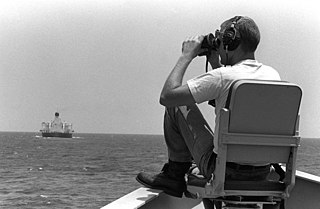
Operation Earnest Will was an American military protection of Kuwaiti-owned tankers from Iranian attacks in 1987 and 1988, three years into the Tanker War phase of the Iran–Iraq War. It was the largest naval convoy operation since World War II.

Operation Praying Mantis was the 18 April 1988 attack by the United States on Iranian naval targets in the Persian Gulf in retaliation for the mining of a U.S. warship four days earlier.
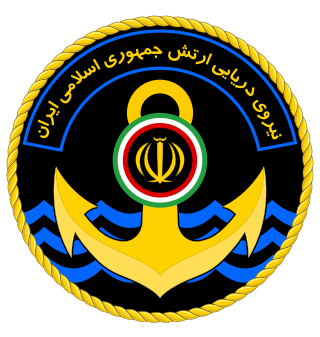
The Islamic Republic of Iran Navy or Iranian Navy, officially abbreviated NEDAJA, is the naval warfare service branch of Iran's regular military, the Islamic Republic of Iran Army (Artesh). It is one of Iran's two maritime military branches, alongside the Navy of the Islamic Revolutionary Guard Corps (IRGC).
The Tanker War, part of the larger Iran–Iraq War, was a series of military attacks by Iran and Iraq against merchant vessels in the Persian Gulf and Strait of Hormuz from 1984 to 1988.

The Iranian Navy traditionally located in the shallow waters of the Persian Gulf, has always been the smallest of the country's military forces. An Iranian navy in one form or another has existed since Achaemenid times in 500 BC. The Phoenician navy played an important role in the military efforts of the Persians in late antiquity in protecting and expanding trade routes along the Persian Gulf and Indian Ocean. With the Pahlavi dynasty in the 20th century that Iran began to consider building a strong navy to project its strength into the Persian Gulf and Indian Ocean. In more recent years, the country has engaged in domestic ship building industries in response to the western-backed Iraqi invasion of Iran, which left it without suppliers during an invasion.

Alborz is an Alvand-class frigate, Vosper Mark V, of the Islamic Republic of Iran Navy. It was supplied to pre-revolutionary Iran's Imperial Iranian Navy by Great Britain, dates back to the time of the Shah of Iran, and was launched in 1969.

The Gulf War of 1990–1991 included an air campaign, as the air forces of the coalition carried out an extensive aerial bombing campaign from 17 January 1991 to 23 February 1991 against Iraq. Spearheaded by the United States, the coalition flew over 100,000 sorties, dropping 88,500 tons of bombs, widely destroying military and civilian infrastructure. The air campaign was commanded by United States Air Force (USAF) lieutenant general Chuck Horner, who briefly served as Commander-in-Chief—Forward of U.S. Central Command while general Norman Schwarzkopf was still in the United States. The British air commanders were Air Vice-Marshal Andrew Wilson and Air Vice-Marshal Bill Wratten. The air campaign had largely finished by 23 February 1991 when the coalition invasion of Kuwait took place.

The Package Q Airstrike was the largest airstrike of the Gulf War and the largest strike of F-16 Fighting Falcon fighter aircraft in military history. Many aircraft, including the F-117 Nighthawk, were used to attack targets in Baghdad, which was the most heavily defended area of Iraq. The same target was hit several times by F-117s, and the last package consisted of seventeen F-111F Aardvarks on the 19th day of the war.
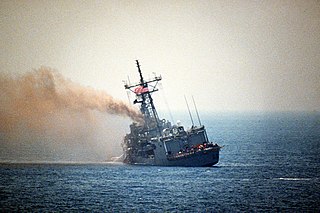
The USS Stark incident occurred during the Iran–Iraq War on 17 May 1987 in Persian Gulf, when an Iraqi jet aircraft fired two Exocet missiles at the U.S. frigate USS Stark. A total of 37 United States Navy personnel were killed or later died as a result of the attack, and 21 were injured.
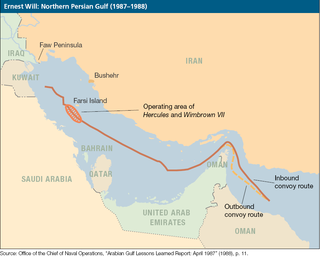
The Bridgeton incident was the mining of the supertanker SS Bridgeton by Iranian IRGC navy near Farsi Island in the Persian Gulf on July 24, 1987. The ship was sailing in the first convoy of Operation Earnest Will, the U.S. response to Kuwaiti requests to protect its tankers from attack amid the Iran–Iraq War.